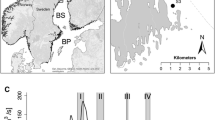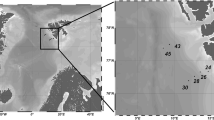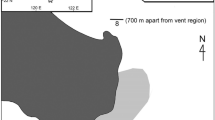Abstract
Mesozooplankton communities in the meso-oligotrophic Gulf of Aqaba, Northern Red Sea, were investigated over a 2 years period (2005–2007) with emphasis on the trophodynamic relations among different taxonomic groups ranging from primary consumers to carnivorous predators. Based on stable isotope analyses, we present evidence for a strong contribution of ‘new’ nitrogen mainly derived from the utilization of aerosol nitrate by unicellular cyanobacteria especially during summer stratification and the propagation of exceptionally low δ15N onto higher trophic levels. In contrast, N2-fixation by diazotrophs seemed to play a minor role, while the utilization of deep water nitrate by cyanobacteria and eukaryotic algae might be of importance during winter mixing. Based on 15N enrichment of consumers, clear differences between exclusively herbivorous organisms (doliolids, appendicularians, pteropods) and those with omnivorous feeding modes were detected. The category of omnivores comprised a large variety of taxons ranging from small meroplanktonic larvae to non-calanoid copepods (harpacticoids, cyclopoids and poecilostomatoids) that together form a diverse and complex community with overlapping feeding modes. In addition, distinct seasonality patterns in δ15N of copepods were found showing elevated trophic positions during periods of winter mixing, which were most pronounced for non-calanoid copepods. In general, feeding modes of omnivores appeared rather unselective, and relative contributions of heterotrophic protists and degraded material to the diets of non-calanoid copepods are discussed. At elevated trophic positions, four groups of carnivore predators were identified, while calanoid copepods and meroplanktonic predators showing lowest 15N enrichment within the carnivores. The direct link between ‘new’ nitrogen utilization by primary producers and the 15N enrichment of consumers in the planktonic food web of the Gulf of Aqaba emphasizes the significant contribution of ‘new’ nitrogen to the nitrogen budget and ecosystem functions in subtropical and tropical oligotrophic oceans.




Similar content being viewed by others
References
Aberle N, Malzahn A (2007) Interspecific and nutrient-dependent variations in stable isotope fractionation: experimental studies simulating pelagic multi-trophic systems. Oecologia 154:291–303
Aberle N, Hillebrand H, Grey J, Wiltshire KH (2005) Selectivity and competitive interactions between two benthic invertebrate grazers (Asellus aquaticus and Potamopyrgus antipodarum): an experimental study using 13C- and 15N-labelled diatoms. Freshw Biol 50:369–379
Agurto C (2007) Assessing mesozooplankton trophic levels in the Baltic Sea and North Sea: a stable isotope study. Dissertation Thesis, University of Kiel, Germany, pp 135
Alldredge AL (1972) Abondonned larvacean houses: a unique food source in the pelagic environment. Science 177:885–887
Al-Najjar T, Badran MI, Richter C, Meyerhoefer M, Sommer U (2007) Seasonal dynamics of phytoplankton in the Gulf of Aqaba, Red Sea. Hydrobiologia 579:69–83
Altabet MA (1988) Variations in nitrogen isotopic composition between sinking and suspended particles—implications for nitrogen cycling and particle transformation in the open ocean. Deep-Sea Res Part A 35:535–554
Bauersachs T, Schouten S, Compaore J, Wollenzien U, Stal LJ, Damste JSS (2009) Nitrogen isotopic fractionation associated with growth on dinitrogen gas and nitrate by cyanobacteria. Limnol Oceanogr 54:1403–1411
Berninger UG, Wickham S (2005) Response of microbial food web to manipulation of nutrients and grazers in the oligotrophic Gulf of Aqaba and northern Red Sea. Mar Biol 147:1017–1032
Boettger-Schnack R, Hagen W, Schnack-Schiel SB (2001) The microcopepod fauna in the Gulf of Aqaba, northern Red Sea: species diversity and distribution of Oncaeidae (Poecilostomatoida). J Plankton Res 23:1029–1035
Boettger-Schnack R, Lenz J, Weikert H (2004) Are taxonomic details of relevance to ecologists? An example from oncaeid microcopepods of the Red Sea. Mar Biol 144:1127–1140
Boettger-Schnack R, Schnack D, Hagen W (2008) Microcopepod community structure in the Gulf of Aqaba and northern Red Sea, with special reference to Oncaeidae. J Plankton Res 30:529–550
Bone Q, Carre C, Ryan KP (2000) The endostyle and the feeding filter in salps (Tunicata). J Mar Biol UK 80:523–534
Boxshall GA, Halsey S (2004) An introduction to Copepod diversity. The Ray Society, London, p 966
Calbet A, Landry MR (1999) Mesozooplankton influences on the microbial food web: direct and indirect trophic interactions in the oligotrophic open ocean. Limnol Oceanogr 44:1370–1380
Calbet A, Landry MR, Scheinberg RD (2000) Copepod grazing in a subtropical bay: species-specific responses to a midsummer increase in nanoplankton standing stock. Mar Ecol Prog Ser 193:75–84
Casciotti KL, Trull TW, Glover DM, Davies D (2008) Constraints on nitrogen cycling at the subtropical North Pacific Station ALOHA from isotopic measurements of nitrate and particulate nitrogen. Deep Sea Res Part II 55:1661–1672
Chen Y, Mills S, Street J, Golan D, Post A, Jacobson M, Paytan A (2007) Estimates of atmospheric dry deposition and associated input of nutrients to Gulf of Aqaba seawater. J Geophys Res Atmosph 112(D4):D04309
Claessens M, Wickham SA, Post AF, Reuter M (2008) Ciliate community in the oligotrophic Gulf of Aqaba, Red Sea. Aquat Microb Ecol 53:181–190
Cornils A, Schnack-Schiel SB, Al-Najjar T, Badran MI, Rasheed M, Manasreh R, Richter C (2007a) The seasonal cycle of the epipelagic mesozooplankton in the northern Gulf of Aqaba (Red Sea). J Mar Syst 68:278–292
Cornils A, Schnack-Schiel SB, Boer M, Graeve M, Struck U, Al-Najjar T, Richter C (2007b) Feeding of Clausocalanids (Calanoida, Copepoda) on naturally occurring particles in the northern Gulf of Aqaba (Red Sea). Mar Biol 151:1261–1274
Dominguez A, Rosas J, Velasquez A, Cabrera T, Mata E (2007) Development, survival and growth of sea urchin Lytechinus variegatus (Lamarck, 1816) (Echinodermata : Echinoidea) fed on microalgae at two different salinities and temperatures. Rev Biol Mar Oceanogr 42:49–57
Dufresne A, Ostrowski M, Scanlan DJ, Garczarek L, Mazard S, Palenik BP, Paulsen IT, de Marsac NT, Wincker P, Dossat C, Ferriera S, Johnson J, Post AF, Hess WR, Partensky F (2008) Unraveling the genomic mosaic of a ubiquitous genus of marine cyanobacteria. Genome Biol 9(5):R90.6
Foster RA, Paytan A, Zehr JP (2009) Seasonality of N2 fixation and nifH gene diversity in the Gulf of Aqaba (Red Sea). Limnol Oceanogr 54:219–233
Fry B (2006) Stable isotope ecology. Springer, New York, p 308
Giesecke R, Gonzalez HE (2004) Mandible characteristics and allometric relations in copepods: a reliable method to estimate prey size and composition from mandible occurrence in predator guts. Revista Chilena De Historia Natural 77:607–616
Go YB, Oh BC, Terazaki M (1998) Feeding behavior of the poecilostomatoid copepods Oncaea spp. on chaetognaths. J Mar Syst 15:475–482
Gonzalez HE, Smetacek V (1994) The possible role of the cyclopoid copepod Oithona in retarding vertical flux of zooplankton fecal material. Mar Ecol Prog Ser 113:233–246
Gordon N, Angel DL, Neori A, Kress N, Kimor B (1994) Heterotrophic dinoflagellates with symbiontic cyanobacteria and nitrogen limitation in the Gulf of Aqaba. Mar Ecol Prog Ser 107:83–88
Hansen T, Sommer U (2007) Increasing the sensitivity of δ 13C and δ 15N abundances measurements by a high sensitivity elemental analyzer connected to an isotope ratio mass spectrometer. Rapid Comm Mass Spectr 21:314–318
Ho JS, Ohtsuka S, Nakadachi N (2006) A new family of poecilostomatoid copepods (Umazuracolidae) based on specimens parasitic on the black scraper (Thamnaconus modestus). Japan Zool Sci 23:483–496
Huys R, Boxshall GA (1991) Copepod evolution. The Ray Society, London, p 468
Kehayias G, Lykakis J, Fragopoulu N (1996) The diets of the chaetognaths Sagitta enflata, S. serratodentata atlantica and S. bipunctata at different seasons in eastern Mediterranean coastal waters. ICES J Mar Sci 53(5):837–846
Kettler GC, Martiny AC, Huang K, Zucker J, Coleman ML, Rodrigue S, Chen F, Lapidus A, Ferriera S, Johnson J, Steglich C, Church GM, Richardson P, Chisholm SW (2007) Patterns and implications of gene gain and loss in the evolution of Prochlorococcus. Plos Genetics 3:2515–2528
Kimor B, Golandsky B (1977) Microplankton of the Gulf of Eilat: aspects of seasonal and bathymetric distribution. Mar Biol 42:55–67
Kleppel GS (1993) On the diets of calanoid copepods. Mar Ecol Prog Ser 99:183–195
Kleppel GS, Frazel D, Pieper RE, Holliday DV (1988) Natural diets of zooplankton off southern California. Mar Ecol Prog Ser 49:231–241
Koski M, Moller EF, Maar M, Visser AW (2007) The fate of discarded appendicularian houses: degradation by the copepod, Microsetella norvegica, and other agents. J Plankton Res 29:641–654
Lindell D, Post AF (1995) Ultraphytoplankton succession is triggered by deep winter mixing in the Gulf of Aqaba (Eilat), Red-Sea. Limnol Oceanogr 40:1130–1141
Mackey KRM, Labiosa RG, Calhoun M, Street JH, Post AF, Paytan A (2007) Phosphorus availability, phytoplankton community dynamics, and taxon-specific phosphorus status in the Gulf of Aqaba, Red Sea. Limnol Oceanogr 52:873–885
Matthews B, Mazumder A (2003) Compositional and interlake variability of zooplankton affect baseline stable isotope signatures. Limnol Oceanogr 48:1977–1987
McClelland JW, Holl CM, Montoya JP (2003) Relating low delta 15N values of zooplankton to N2-fixation in the tropical North Atlantic: insights provided by stable isotope ratios of amino acids. Deep-Sea Res Part I 50:849–861
Meyer-Claeden O (2007) Vertikale und horizontale Verteilungsmuster der Zooplanktongemeinschaften am Senghor-Seeberg (Kapverdische Inseln). Diploma thesis, University of Kiel, Germany, pp 86
Mintenbeck K, Jacob U, Knust R, Arntz WE, Brey T (2007) Depth-dependence in stable isotope ratio delta N-15 of benthic POM consumers: the role of particle dynamics and organism trophic guild. Deep-Sea Res Part I 54:1015–1023
Montoya JP, Horrigan SG, McCarthy JJ (1990) Natural abundance of 15N in particulate nitrogen and zooplankton in the Chesapeake Bay. Mar. Ecol. Prog. Ser. 65:35–61
Montoya JP, Wiebe PH, McCarthy JJ (1992) Natural abundance of 15N in particulate nitrogen and zooplankton in the Gulf-Stream Region and Warm-Core Ring 86a. Deep-Sea Res Part A 39:S363–S392
Montoya JP, Carpenter EJ, Capone DG (2002) Nitrogen fixation and nitrogen isotope abundances in zooplankton of the oligotrophic North Atlantic. Limnol Oceanogr 47:1617–1628
Montoya JP, Holl CM, Zehr JP, Hansen A, Villareal TA, Capone DG (2004) High rates of N2 fixation by unicellular diazotrophs in the oligotrophic Pacific Ocean. Nature 430:1027–1031
Mullin MM, Rau GH, Eppley RW (1984) Stable nitrogen isotopes in zooplankton—some geographic and temporal variations in the North Pacific. Limnol Oceanogr 29:1267–1273
Nakamura Y, Turner JT (1997) Predation and respiration by the small cyclopoid copepod Oithona similis: how important is feeding on ciliates and heterotrophic flagellates? Plankton Res 19:1275–1288
Paffenhoefer G-A (1993) On the ecology of marine cyclopoid copepods (Crustacea, Copepods). J Plankton Res 15(1):37–55
Post D (2002) Using stable isotopes to estimate trophic position: models, methods, and assumptions. Ecology 83:703–718
Post AF, Dedej Z, Gottlieb R, Li H, Thomas DN, El-Absawi M, El-Naggar A, El-Gharabawi M, Sommer U (2002) Spatial and temporal distribution of Trichodesmium spp. in the stratified Gulf of Aqaba, Red Sea. Mar Ecol Progr Ser 239:241–250
Saito H, Kiorboe T (2001) Feeding rates in the chaetognath Sagitta elegans: effects of prey size, prey swimming behaviour and small-scale turbulence. J Plankton Res 23:1385–1398
Scanlan DJ, Ostrowski M, Mazard S, Dufresne A, Garczarek L, Hess WR, Post AF, Hagemann M, Paulsen I, Partensky F (2009) Ecological genomics of marine picocyanobacteria. Microbiol Molecul Biol Rev 73:249–299
Sommer U, Berninger UG, Boettger-Schnack R, Cornils A, Hagen W, Hansen T, Al-Najjar T, Post AF, Schnack-Schiel SB, Stibor H, Stuebing D, Wickham S (2002) Grazing during early spring in the Gulf of Aqaba and the northern Red Sea. Mar Ecol Prog Ser 239:251–261
Terazaki M (1998) Life history, distribution, seasonal variability and feeding of the pelagic chaetognath Sagitta elegans in the Subarctic Pacific: a review. Plankton Biol Ecol 45:1–17
Turner JT (1986) Zooplankton feeding ecology: contents of fecal pellets of the cyclopoid copepods Oncaea venusta, Corycaeus amazonicus, Oithona plumifera and O. simplex from the northeastern Gulf of Mexico. Mar Ecol 28:9–302
Turner JT (2004) The importance of small planktonic copepods and their roles in pelagic marine food webs. Zool Stud 43(2):255–266
Waite AM, Muhling BA, Holl CM, Beckley LE, Montoya JP, Strzelecki J, Thompson PA, Pesant S (2007) Food web structure in two counter-rotating eddies based on delta 15N and delta 13C isotopic analyses. Deep-Sea Res Part II 54:1055–1075
Wankel SD, Chen Y, Kendall C, Post AF, Paytan A (2009) Sources of aerosol nitrate to the Gulf of Aqaba: evidence from δ15N and δ18O of nitrate and trace metal chemistry. Mar Chem doi:http://doi.org/10.1016/j.marchem.2009.01.013(in press)
Webb EA, Ehrenreich IM, Brown SL, Valois FW, Waterbury JB (2009) Phenotypic and genotypic characterization of multiple strains of the diazotrophic cyanobacterium Crocosphaera watsonii isolated from the open ocean. Environ Microbiol 11:338–348
Wickstead JH (1962) Food and feeding of pelagic copepods. Proc Zool Soc Lond 139:545–555
Zehr JP, Waterbury JB, Turner PJ, Montoya JP, Omoregie E, Steward GF, Hansen A, Karl DM (2001) Unicellular cyanobacteria fix N2 in the subtropical North Pacific Ocean. Nature 412:635–638
Zehr JP, Bench SR, Carter BJ, Hewson I, Niazi F, Shi T, Tripp HJ, Affourtit JP (2008) Globally distributed uncultivated oceanic N2-fixing cyanobacteria lack oxygenic photosystem II. Science 322(5904):1110–1112
Acknowledgments
This study was funded by the German–Israeli Foundation for Scientific Research and Development (GIF Grant No.: I-732-54.8/2002). We are grateful to the staff of the Interuniversity Institute for Marine Sciences in Eilat, Israel, and especially Marc Chernichovsky and Roy Holzmann for their helpful support during the field campaign. Special thanks go to Dorit Golan and Sigrid Penno who helped us substantially to organize the field campaign and enabled a pleasant sojourn. Monika Claessens is thanked for her kind support and valuable ideas during the initiation of the field campaign. We are grateful to Arne Malzahn and two anonymous reviewers for their fruitful comments on earlier versions of the manuscript. Thanks are due to Dr. K. Schulz (German Centre for Marine Biodiversity Research) for the identification of calanoid copepod species. Financial support to RBS from the German Science Foundation (SCHN 455/4-1) is gratefully acknowledged.
Author information
Authors and Affiliations
Corresponding author
Additional information
Communicated by X. Irigoien.
Rights and permissions
About this article
Cite this article
Aberle, N., Hansen, T., Boettger-Schnack, R. et al. Differential routing of ‘new’ nitrogen toward higher trophic levels within the marine food web of the Gulf of Aqaba, Northern Red Sea. Mar Biol 157, 157–169 (2010). https://doi.org/10.1007/s00227-009-1306-y
Received:
Accepted:
Published:
Issue Date:
DOI: https://doi.org/10.1007/s00227-009-1306-y




